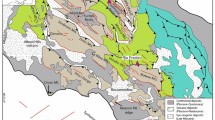Abstract
Continuous radon monitoring in soil and groundwater is one of the useful methods in earthquake prediction process. There are many published studies on geochemical precursors to seismic activity, both reporting the detection of validated precursory phenomena. The research on geochemical precursory algorithms is aimed at defining quantitative relations between seismogenic parameters and endogenetic components. This paper presents a new analytical algorithm that can be used to estimate optimum location and magnitude of coming earthquakes based on variations in radon concentration or any other geochemical precursors. In a real life application of this algorithm, radon monitoring network for Kerman province has been designed and the resulting data have been investigated. This practical example corroborates the proposed algorithm as well and the resulting seismogenic parameters e.g. location and magnitude have been obtained within their acceptable ranges. Furthermore, the proposed algorithm emphasizes on hot-springs which have the most effect on results around target zone.










Similar content being viewed by others
Notes
International Association of Seismology and Physics of the Earth’s Interior (www.iaspei.org).
International Institute of Earthquake Engineering & Seismology (www.iiees.ac.ir).
References
Lahr J, Chouet B, Stephens C, Power J, Page R (1994) Earthquake classification, location, and error analysis in a volcanic environment: implications for the magmatic system of the 1989–1990 eruptions at Redoubt Volcano, Alaska. J Volcanol Geotherm Res 62(1):137–151
Sibson RH (1983) Continental fault structure and the shallow earthquake source. J Geol Soc 140(5):741–767
Namvaran M, Negarestani A (2012) Measuring the radon concentration and investigating the mechanism of decline prior an earthquake (Jooshan, SE of Iran). J Radioanal Nucl Chem:1–8. doi:10.1007/s10967-012-2162-7
Toutain J-P, Baubron J-C (1999) Gas geochemistry and seismotectonics: a review. Tectonophysics 304(1–2):1–27. doi:10.1016/s0040-1951(98)00295-9
Negarestani A, Setayeshi S, Ghannadi-Maragheh M, Akashe B (2003) Estimation of the radon concentration in soil related to the environmental parameters by a modified Adaline neural network. Appl Radiat Isot 58(2):269–273. doi:10.1016/s0969-8043(02)00304-4
Ghosh D, Deb A, Sengupta R (2009) Anomalous radon emission as precursor of earthquake. J Appl Geophys 69(2):67–81. doi:10.1016/j.jappgeo.2009.06.001
Musavi Nasab S, Negarestani A, Mohammadi S (2011) Modeling of the radon exhalation from water to air by a hybrid electrical circuit. J Radioanal Nucl Chem 288(3):813–818. doi:10.1007/s10967-011-1003-4
Kuo T, Su C, Chang C, Lin C, Cheng W, Liang H, Lewis C, Chiang C (2010) Application of recurrent radon precursors for forecasting large earthquakes (Mw > 6.0) near Antung, Taiwan. Radiat Meas 45(9):1049–1054. doi:10.1016/j.radmeas.2010.08.009
Chyi LL, Quick TJ, Yang TF, Chen CH (2010) The experimental investigation of soil gas radon migration mechanisms and its implication in earthquake forecast. Geofluids 10(4):556–563. doi:10.1111/j.1468-8123.2010.00308.x
Porstendörfer J (1994) Properties and behaviour of radon and thoron and their decay products in the air. J Aerosol Sci 25(2):219–263
Qureshi A, Khan H, Jafri E, Tufail M (1991) Radon signals for geological explorations. Int J Radiat Appl Instrum D 19(1–4):383–384
Papastefanou C (2002) An overview of instrumentation for measuring radon in soil gas and groundwaters. J Environ Radioact 63(3):271–283
Kagan YY, Jackson DD (1991) Long‐term earthquake clustering. Geophys J Int 104(1):117–134
Keilis-Borok V (1996) Intermediate-term earthquake prediction. Proc Natl Acad Sci USA 93(9):3748
Etiope G, Calcara M, Quattrocchi F (1997) Seismogeochemical algorithms for earthquake prediction: an overview. Annali Di Geofisica 40:1483–1492
Wyss M (1991) Evaluation of proposed earthquake precursors. Eos Trans Am Geophys Union 72(441):445–446
Singh M, Ramola RC, Singh B, Singh S, Virk HS (1991) Subsurface soil gas radon changes associated with earthquakes. Int J Radiat Appl Instrum D 19(1–4):417–420. doi:10.1016/1359-0189(91)90229-b
Yasuoka Y, Ishii T, Tokonami S, Ishikawa T, Narazaki Y, Shinogi M (2005) Radon anomaly related to the 1995 Kobe earthquake in Japan. Int Congr Ser 1276:426–427. doi:10.1016/j.ics.2004.10.011
Wyss M, Booth DC (1997) The IASPEI procedure for the evaluation of earthquake precursors. Geophys J Int 131(3):423–424
Zavyalov A (2005) Medium-term prediction of earthquakes from a set of criteria: Principles, methods, and implementation. Russ J Earth Sci 7(1):51–73
Dobrovolsky IP, Zubkov SI, Miachkin VI (1979) Estimation of the size of earthquake preparation zones. Pure Appl Geophys 117(5):1025–1044. doi:10.1007/bf00876083
Keilis-Borok V, Kossobokov V (1990) Premonitory activation of earthquake flow: algorithm M8. Phys Earth Planet Inter 61(1–2):73–83
Keilis-Borok V, Rotwain I (1990) Diagnosis of time of increased probability of strong earthquakes in different regions of the world: algorithm CN. Phys Earth Planet Inter 61(1–2):57–72
Tsunomori F, Kuo T (2010) A mechanism for radon decline prior to the 1978 Izu-Oshima-Kinkai earthquake in Japan. Radiat Meas 45(1):139–142. doi:10.1016/j.radmeas.2009.08.003
Walker RT, Talebian M, Saiffori S, Sloan RA, Rasheedi A, MacBean N, Ghassemi A (2010) Active faulting, earthquakes, and restraining bend development near Kerman city in southeastern Iran. J Struct Geol 32(8):1046–1060. doi:10.1016/j.jsg.2010.06.012
Walker RT (2006) A remote sensing study of active folding and faulting in southern Kerman province, S.E. Iran. J Struct Geol 28(4):654–668. doi:10.1016/j.jsg.2005.12.014
Shahabpour J (2005) Tectonic evolution of the orogenic belt in the region located between Kerman and Neyriz. J Asian Earth Sci 24(4):405–417. doi:10.1016/j.jseaes.2003.11.007
Mohajer-Ashjai A, Behzadi H, Berberian M (1975) Reflections on the rigidity of the Lut Block and recent crustal deformation in eastern Iran. Tectonophysics 25(3–4):281–301. doi:10.1016/0040-1951(75)90066-9
Berberian M, Asudeh I, Arshadi S (1979) Surface rupture and mechanism of the Bob-Tangol (southeastern Iran) earthquake of 19 December 1977. Earth Planet Sci Lett 42(3):456–462. doi:10.1016/0012-821x(79)90055-4
Berberian M (1995) Master “blind” thrust faults hidden under the Zagros folds: active basement tectonics and surface morphotectonics. Tectonophysics 241(3–4):193–224. doi:10.1016/0040-1951(94)00185-c
Nussbaum E, Harsh JB (1958) Radon solubility in fatty acids and triglycerides. J Phys Chem 62(1):81–84
Shahpasandzadeh M, Heidari M (1996) Report of initial investigation of seismotectonic and earthquake faulting risk in Kerman province zone; Mordad 1375 (in persian language), vol 1. IIEES publication
Acknowledgments
The authors are extremely grateful to Dr. Alireza Ahmadi & Mr. Ehsan Mehrabi-Kermani for editing text & Mr. Mohsen Bagheri for his guides in drawing figures.
Author information
Authors and Affiliations
Corresponding author
Rights and permissions
About this article
Cite this article
Hashemi, S.M., Negarestani, A., Namvaran, M. et al. An analytical algorithm for designing radon monitoring network to predict the location and magnitude of earthquakes. J Radioanal Nucl Chem 295, 2249–2262 (2013). https://doi.org/10.1007/s10967-012-2310-0
Received:
Published:
Issue Date:
DOI: https://doi.org/10.1007/s10967-012-2310-0




